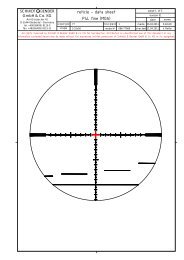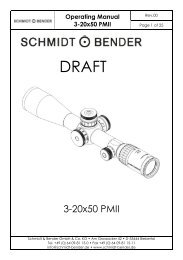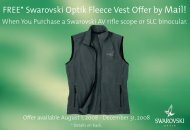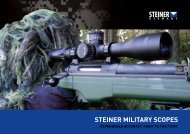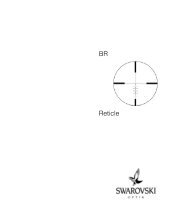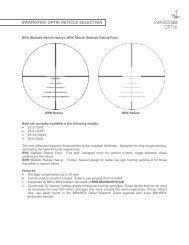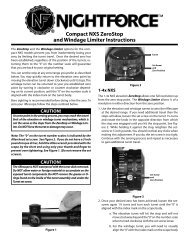Create successful ePaper yourself
Turn your PDF publications into a flip-book with our unique Google optimized e-Paper software.
Muzzle Loaders note:We have provided a 50 cal. Muzzle Loader factorsticker based upon a 100 yard zero, a muzzle velocityof about 1600 feet per second and a ballistic coefficientof about .180. The 4 marker bars will be 125, 150,175 and 200 yards respectively. Since muzzle loadingfirearms are increasingly capable of faster muzzlevelocities and ever changing bullets, we suggestentering your data into the <strong>TDS</strong> ballistic calculator onour website at www.swarovskioptik.com for the mostaccurate results.Adjusting for CrosswindLook at the four Range Marker Bars (RMB’s) located justbelow the center horizontal reticle line. Note, the right andleft end of each RMB is the aiming point that you are to usewhen adjusting for an approximate 10 mph. cross wind.If the wind is from the left, you should use the right tip ofthe wind bar as your aiming point, at the desired rangeand then “hold into the wind”. If the wind is from the right,the opposite - left tip of the bar would become your aimingpoint. As before, always “hold in to the wind”.A 5 mph. crosswind, you would estimate half of the widthof the RMB right or left of the center vertical reticle line.A 20 mph. crosswind would require you to estimate doublethe width of the RMB, right or left of the center verticalreticle line.In the Field - Putting it all togetherRange, Wind and Angle with the <strong>TDS</strong> <strong>Reticle</strong>The <strong>TDS</strong> Tri-Factor <strong>Reticle</strong> may also be used to determinethe range to an animal at various distances. To do thisyou will need to first know the depth of the chest areaof the game you are expecting to look at. Please referto the Animal Silhouette Depth Chart table in the back ofthis brochure.Procedure:The following example uses a 30-06 rifle, firing a 165grain bullet at 2800 fps factor number 8.7, to take aBull Elk with a 24” Chest, standing at 300 yards in a10 m.p.h. right to left cross wind at a 45° angle uphillincline. Please refer to the graphic diagrams, Figures#1, 2 and 3 and follow the following three steps.7Ranging to a targetStep A. Mount your rifle and locate your animal in thescope. Make sure the scope is on its maximum power.Measure the yardage to the target by sliding the crosshairto the top of its back at the shoulder area. Holdingthat position, drop your eyes down to the bottom ofthe chest. Determine where the bottom of the chest isin relation to the marker bars. Now look at the gridlineon the left side of your <strong>TDS</strong> decal to see what gridlinenumber matches up with the level of the bottom of thechest. (You will only see the gridlines on the decal.The gridlines will not appear in the rifle scope). In theexample in figure 1 the bottom of the chest lines up justunderneath the 3 rd Marker Bar that will line up with thegridline # 8 on the decal. Now take that 8 and divide itinto the known chest depth of 24 to get 3. Multiply 3.0times 100 to get 300 yards as the distance to the targetin this example.2 nd example: You’re shooting a Couse deer with aknown chest depth of 12”. The bottom of the chestlines up with gridline 5. 5 divided into 12 equals 2.4.2.4 times 100 equals 240 yards. In this case you wouldhold half way between the 200 and 300 yard MarkerBars.Compensating for windStep B. You’ve determined the elk is 300 yards awaybut there is a 10 mph crosswind blowing from right toleft. Slide the reticle up the animal’s body centering the300 yard range marker bar where you want the bulletto hit (BIP= bullet impact point). Maintaining elevation,slide the range marker bar to the right or into the winduntil the left end of that marker bar is on the desiredbullet impact point. (Fig. 2)Compensating for anglesStep C. To correct for a 45 degree angle in thisexample simply move the from the 300 yard marker barup to the 200 yard marker bar (see figure 3). The effectof gravity on a bullet at angles is less than that over flathorizontal planes. To give you a better understandingof this effect consider that this 30 cal 165 grain bulletat 2800 fps with a 100 yard zero drops 14.4 inches at300 yards over a horizontal flat plane. Changing onlythe angle of the shot to 45 degrees, up or down, overthe same 300 yard distance, the bullet drops only 7.3inches.With a minimum amount of practice, this whole proceedurecan be accomplished in about 3 to 5 seconds.8



